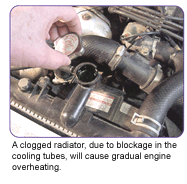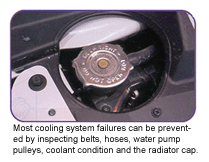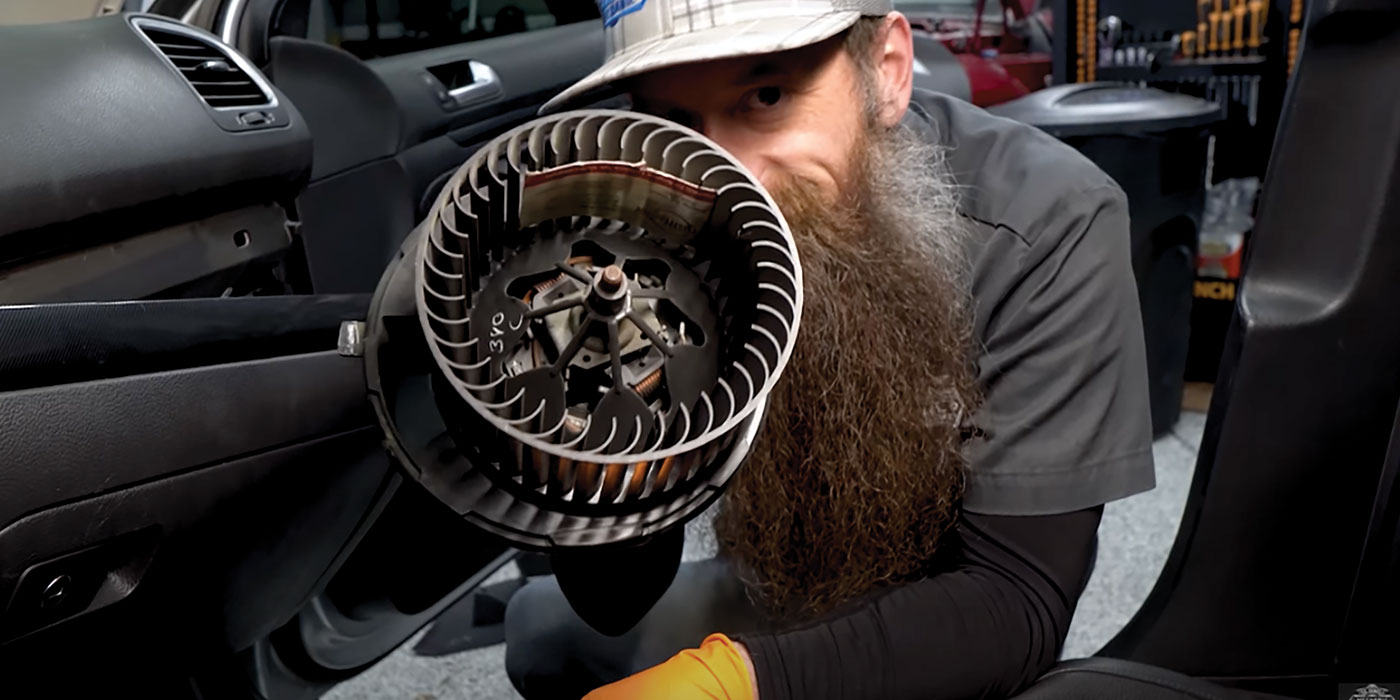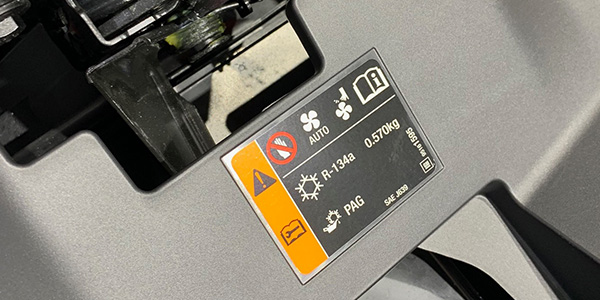By now, it’s obvious to most service shops that cooling system service is an absolute “must-do” on any nameplate. Once a cooling system suffers long-term neglect, it turns into an ongoing source of problems for the owner and his service technician because, when corrosion starts to take place, the effects can’t be reversed. For that single reason, it’s especially important to sell your customers the “Complete Cooling System Service.”
Last month, we addressed some radiator clogging issues (see “Ending Coolant Flow Restrictions,” July Underhood Service). This month, we look at all of the remaining components of the vehicle’s cooling system.
The first step to a cooling system check is to look for corrosive influences. Remember, ethylene glycol-based coolants incorporate a considerable additive package that’s designed to control the extremely corrosive tendencies of the coolant itself. The additive package not only prevents corrosion, it also prevents electrolysis, which is the tendency of different metals to dissolve and migrate throughout the coolant. This migration is caused by a mild electric current flow that is caused by dissimilar metals being suspended in a water-based liquid. Thus, when the additive package is depleted, critical gasket sealing surfaces become eroded and coolant passage tubes in the radiator become clogged. In addition, sediment caused by rust from iron cylinder blocks settles to the bottom of the engine’s water jackets, which further decreases the ability of the coolant to dissipate heat.
Once corrosion and electrolysis wreak havoc throughout the cooling system, the future life of the cooling system has been compromised to the point that replacing radiators, heater cores, cylinder head gaskets and other expensive components will become common practice for the owner. As for water pumps, consider that when highly abrasive iron oxides become suspended in the coolant, the life of any new water pump seal becomes severely limited.
Radiator Inspection
 In order to make radiators lighter and more efficient, manufacturers began making the cooling tubes thinner and packing more cooling fins between the tubes. The downsides of such a design, obviously, are cooling tubes that will clog easily and fins that rapidly accumulate road debris. Because of these two factors, water pumps must develop more pressure to circulate coolant, and electric cooling fans must run faster to draw air through denser radiator cores. The objective of any complete cooling system service, of course, is to keep the radiator core as internally and externally clean as possible.
In order to make radiators lighter and more efficient, manufacturers began making the cooling tubes thinner and packing more cooling fins between the tubes. The downsides of such a design, obviously, are cooling tubes that will clog easily and fins that rapidly accumulate road debris. Because of these two factors, water pumps must develop more pressure to circulate coolant, and electric cooling fans must run faster to draw air through denser radiator cores. The objective of any complete cooling system service, of course, is to keep the radiator core as internally and externally clean as possible.
Keep in mind that clogged radiators tend to cause gradual engine overheating, particularly when the vehicle is climbing long gradients over plateaus and high mountain passes. The overheating occurs because a critical number of radiator cooling tubes are clogged. The clogging usually occurs because dirty coolant has been poured back into the radiator after a cooling system component, like a water pump, has been replaced. The clogging may also take place after a severe overheating condition has occurred, when sediment from the engine water jackets has been deposited in the radiator core tubes. Although reverse-flushing might remove some of the clogging, I would recommend that the radiator either be replaced or repaired, especially if the overheating condition has reached the severe stage.
Cooling Fans
Like the radiator, electric cooling fan performance is often taken for granted. In reality, modern cooling fan design and operating strategy have become very sophisticated. Some fans are designed as two-speed units, with the low-speed application being used, let’s say, 90% of the time. The only time the high-speed application will activate is during high temperatures or high loads.
Consequently, when performing the complete cooling system service, it’s very important to test the cooling fan for its correct programmed operation. In most applications, the cooling fan will activate when the air conditioning system or compressor clutch is activated. Other applications may require coolant outlet temperatures to rise as high as 230° F before the PCM will command the fan relay to close and activate the cooling fan itself.
When testing a two-speed fan application, it’s important to first understand what the operating strategy of the fan happens to be. The high-speed portion of the fan’s controls often can be activated with the bi-directional controls on a scan tool. In other cases, the coolant temperature or throttle opening must be high enough to activate the high-speed portion of the fan.
It’s also important to be aware that high-capacity fans draw more electrical current than low-capacity fans. If a low-amperage motor has been substituted for a high-amperage application, it won’t properly cool the radiator. So it’s very important never to assume that the fan is operating correctly just because it activates when the engine reaches a predetermined operating temperature.
Symptoms of a Defective Fan Clutch
Oily streaks on the clutch housing;
Play in the clutch bearing (wobbling);
Freewheeling (a good fan should not turn more than one to one-and-a-half turns if spun by hand);
Binding (frozen).
Thermostats
Several manufacturers have recently issued statements about severe engine damage caused by the effects of sludging and gelling of crankcase oil in their engines. In my experience, when the water condensation is combined with oil and combustion byproducts like carbon and sulfur, the oil thickens into sludge. This sludge accumulates inside the engine and eventually clogs the oil pickup screen and vital lubrication passages.
 Gelling, on the other hand, is usually caused by the long-term oxidation of hot oil. As neglected crankcase oil begins to oxidize, it forms a gelatin-like substance that, like sludge, clogs vital lubrication passages in the engine.
Gelling, on the other hand, is usually caused by the long-term oxidation of hot oil. As neglected crankcase oil begins to oxidize, it forms a gelatin-like substance that, like sludge, clogs vital lubrication passages in the engine.
It’s important to understand that, while sludging or gelling is primarily caused by neglected or unperformed oil changes, it is also aggravated by poorly performing cooling systems. In years past, engines were operated at 195° F in order to better vaporize the fuel and evaporate condensation from the crankcase oil. In direct contrast, some engine designers are now actually running their engines cooler, often at 170-180° F operating temperature, in order to accommodate higher static compression ratios.
Consequently, the role that the ever-so-humble thermostat plays in engine performance and longevity is increasingly important. For example, it’s important to verify thermostat operation with a non-contact pyrometer and then compare that temperature reading with the OBD II data stream temperature reading. If the temperature readings don’t agree or if either of them is out of specification, the engine’s exhaust emissions, performance, fuel economy and overall operating life will be affected. Considering the relatively low price of a quality, OEM-spec thermostat, it’s wise to replace the thermostat whenever the cooling system is drained for any other service.
Belts and Hoses
Clearly, hoses and drive belts are the most under-sold service on today’s vehicles, primarily because it’s not uncommon for many belts and hoses to look like they’re brand-new, even after 60,000-80,000 miles of service. Ideally, new hoses should be sold during a water pump or timing belt replacement. In reality, many service writers and techs take a pass on new hoses to keep the estimate low and avoid the perception of selling “unneeded services.”
Unfortunately, an aging hose or belt usually breaks at the most inconvenient time and location. To make matters more complicated, most heater, throttle body and radiator hoses on modern vehicles (especially imports) are custom-molded, which means that many of these hoses are available only on overnight parts orders.
As for accessory drive belts and timing belts, keep in mind that, depending upon the application, both can drive the all-essential water pump. A failure of the belt means that the vehicle is sidelined until the belt is replaced. Again, serpentine belts are usually application-specific, which means that if the vehicle fails in a rural locality, the driver suffers a major inconvenience.
Prevention is the Best Policy
The objective of selling the complete cooling system service is to prevent future failures. Indeed, 99% of most cooling system failures can be prevented by the simple inspection of the radiator cap, belts, hoses, water pump idler pulleys and coolant condition. If the vehicle hasn’t received scheduled maintenance on its cooling system, it’s time to inspect the system for damage and prepare a service estimate. After all, the most profitable services are the complete services, which, in this case, is the “Complete Cooling System Service.”







